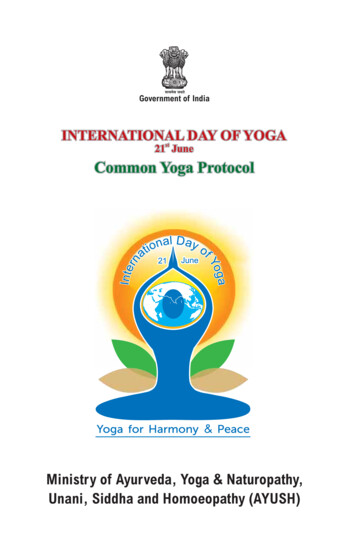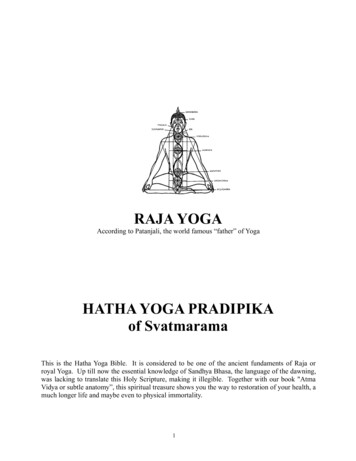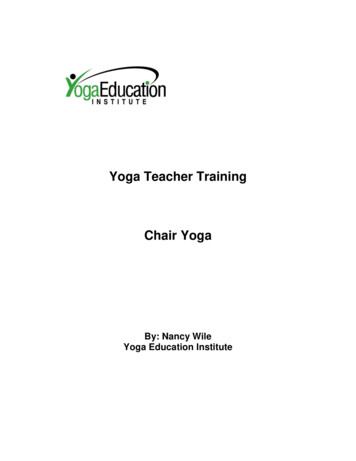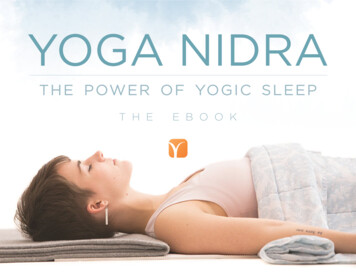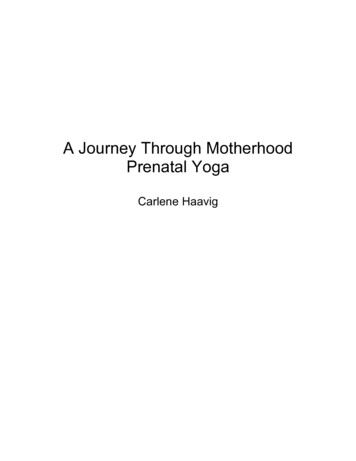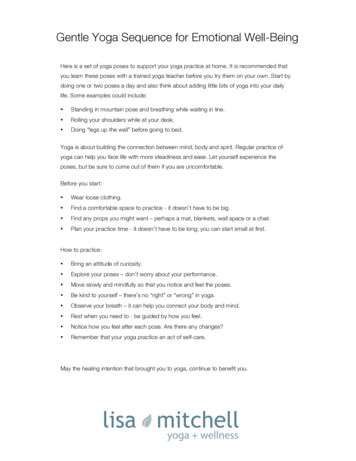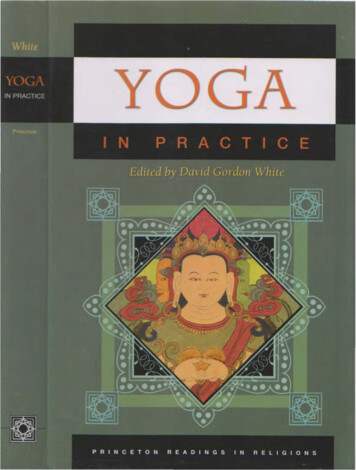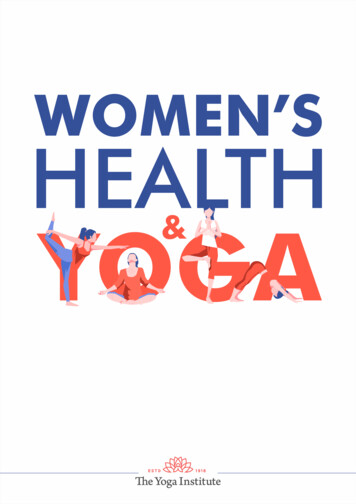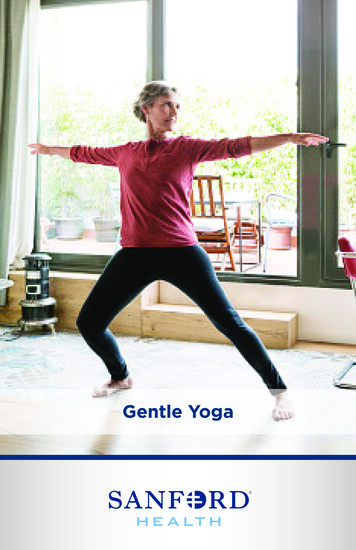
Transcription
Gentle Yoga
IntroductionYoga stresses balance, strength-building, and alignment. Lowimpact yoga can help with bone growth and build stronger bones.Light back-bending positions can help open or spread out thespine and build strength here. There are some positions thatshould be avoided if you have osteoporosis. Before starting a yogaprogram, talk to your doctor about the risks and benefits.What Is Gentle Yoga?Let’s start by talking about what yoga is not. Yoga is not a beliefsystem or religion. Yoga is way to exercise that helps your body,mind and spirit feel better.The term yoga means union (or joining together) of the mind, bodyand spirit in Sanskrit, the language of early India. Yoga has beenpracticed for centuries in many forms.Gentle yoga is a type of yoga which does as its name suggests. Thisis a low-impact, gentle method of yoga. It is not as hard as otherforms of yoga. Gentle yoga is for persons who should not or cannotmeet the demands of physically-straining exercises.Be sure you talk to your main doctor before starting gentle yoga ifyou have osteoporosis or low bone density.Is Gentle Yoga Okay for Me if I Cannot bend well Carry extra weight Have a health condition that limits my activity Have bad joints (hips, knees, etc.) Have low back pain Have trouble focusing Have not exercised much in the pastThen gentle yoga may be a good choice for you!2
How Can Gentle Yoga Help Me? Improves balance Improves posture Reduces stress Strengthens bones Strengthens muscles Stretches muscles for better movementHow Can Gentle Yoga Be an Advantage to You? It is a very flexible type of exercise. I t can be practiced in the comfort of your own home or ina class setting. At home, it can be done with a video or using this handout. I f done in a class or if a video is used, be sure the trainer orvideo knows about osteoporosis and positions that shouldnot be done. I t does not call for special equipment. Most of the items arefound in your home. I t can be a social event or offer personal time. You can do itwith friends or alone. It can help you unwind, stretch, gain strength or breathe better.Breathing Is KeyEven though we breathe every day, all day, controlled deepbreathing can provide more oxygen than usual breathing.Oxygen is vital for the body’s organs, especially the heart and brain.This controlled deep breathing in yoga takes practice, especiallywhen this type of breathing is done while doing yoga. Other namesfor this controlled deep breathing are Thoughtful Breathing orConscious Breathing.3
Ocean BreathOcean breath is a common type of controlled deep breathing.This will be a very helpful method of breathing as you go throughyoga workouts. Breathe in (inhale) through your nose for 4 seconds. Breathe out (exhale) through your nose for 4 seconds. Breaths are smooth and even. There should not be any startsand stops of breaths through the inhaling and exhaling process.Become a Noisy BreatherAs you become better at breathing through your nose, start tobreathe a little louder. Breathe just loudly enough that someonestanding next to you could hear you breathing. This might soundlike gentle waves rolling onto the shore. The rhythmic sound ofthese gentle waves will help relax you into the yoga positions.Quiet and Prepare Your MindAs you practice breathing and focus on the sounds and feel ofbreathing, you may find that you are able to quiet the noises in yourmind that are reminding you to: Pick up some groceries on the way home Call your neighbor Buy a gift for your nieceThese should fade away during the yoga breathing. Many peoplewho practice yoga believe that the focus on breathing is one of thereasons they can quiet their mind and focus better during the day.This will take practice and hopefully, this will happen for you, too.Yoga Positions4You will find many types of yoga, yoga stretches or positions.Practice some easy positions. Try these gentle positions, and thentry other types of yoga if you wish. If a person has fragile (weak)bones, always be careful to use gentle positions and talk with your
doctor and the experts in yoga for persons with osteoporosis.Hold the position (based on your ability) for four to six controlleddeep breaths. One breath is an inhale and then an exhale in onesmooth movement.Forward bends of the spine place pressure on the vertebrae (backbones). When this is done with a spine that is weakened byosteoporosis, this can hurt the spine.Do Not Do These Poses Where you lie on your back and pull your legs towardyour chest Headstands The plow Shoulder stands Twists Jumping Abdominal (belly) crunchesBalancing positions can be done while standing. This helps: Body awareness Concentration (focus) Muscle strengtheningIf you have weakened hips or poor balance, use props such as achair or wall to help keep you safe.A strong abdomen (belly) and core muscles support the spineand promote good posture. This has huge benefits for personswith osteoporosis. Avoid positions that do not support your neck and spine orcompress (squeeze) the spine. A void the boat pose if you do not have strong enough musclesto support your neck and spine well. Do not do any exercise that places your body’s weight on yourneck. This can lead to spinal damage in this area.5
Items Most Often Used Yoga mat, towel or blanket One or two sturdy, armless chairs (A wheelchair with removablearmrests works well, too) Yoga block(s) or a small stool, about six to ten inches tall (optional)Warm Up First!Some gentle warm-ups help prepare the heart, muscles and joints forthis yoga session. Try the deep controlled breathing followed by: Side stretches Arm circles Lifting above your head and lowering your arms March in place or while sittingTwo “Gentle” Choices Very Gentle Yoga (VGY) Persons who are new to yoga shouldstart here. This level is ideal for persons who have: Poor balance, flexibility or strength Trouble standing for short periods Trouble going down to the floor and getting back up Gentle Yoga (GY) These positions are for persons who must: Have fair strength and flexibility for these positions Be able to stand safely during the position Be able to get down to the floor and back upThe next pages show positions that are labeled “VGN” for VeryGentle Yoga or “GY” for Gentle Yoga. Try the “GY” positions onlyif you feel able.6
Mountain PositionVGYThis is a simple position thatcan prepare you for all the otherpositions. It is a way to embracethe deep controlled breathingand begin a yoga practice. Sit tall with your back notsupported by the chair. Press feet flat on floor. Relax shoulders. S tretch your whole spineupward and lift the top ofyour head to the sky.Mountain PositionGY Stand with the feet athip-width apart. Relax shoulders. Keep hands at side;stretching hands toward feet. Press feet flat, evenly on floor. Stretch your whole spineupward and lift the top ofyour head to the sky.7
ExtendedMountainPosition VGY Sit tall with your back notsupported by the chair. Stand with the feet athip-width apart. Relax shoulders. Tighten your thigh andbelly muscles by pressingfeet down into floor. S tretch hands highabove your head,shoulder-width apart. Tighten your thigh andbelly muscles by pressingfeet down into the floor. Stretch your whole spineupward and lift the top ofyour head to the sky.8ExtendedMountainPosition GY Stretch hands high above,shoulder-width apart. Relax shoulders. S tretch your whole spineupward and lift the top ofyour head to the sky.
Cat Position VGY(Exhale)The Cat Position is often usedwith the Cow Position. Movebetween the two positionssmoothly and slowly while takinga deep controlled breath. Sit tall with your back notsupported by the chair. Press feet flat on floor. Pull in belly muscles. Tip pelvis and hip bonesbackward to round back.Cow Position VGY(Inhale) Sit tall with your back notsupported by the chair. Relax belly muscles. T ip pelvis and hip bonesforward and hollow outback (concave). Lift chin and chest gently. Press shoulders backand down. If you have osteoporosis,keep your back flat.(Do not round your back). Tuck chin down. Round shoulders forward.9
Cat Position GY (Exhale) Begin with hands and knees on floor. Pull in belly muscles to round back.If you have osteoporosis, keep your back flat.(Do not round your back). Bring chin toward caved chest.Cow Position GY (Inhale) Begin with hands and knees on floor. Lift chin; open chest. Press shoulders back. Allow belly to sink downward, to hollow out back (concave).10
Boat Position VGY Sit sideways on chair. Tighten belly muscles and round your back slightly. Hold back of chair with inside hand; lift chest upward. K eep spine straight; lift one leg, bending knee slightly; holdback of knee with hand. Repeat on other side.A more advanced Boat Position can be tried by lifting the secondleg and stretching it straight out into the air while keeping yourbalance on the chair.11
Boat Position GY Sit on floor with the legs stretched in front. Bend knees slightly. Place hands behind knees to start. Rock back slightly to balance. Lift feet to have lower legs even to floor. Keep spine straight; lift chest upward. Reach arms forward if possible and when ready; relax shoulders.12
Tree Position VGYThis is a one-legged balancing pose that builds trust in yourselfand helps center the mind. It is not easy to think about your stresswhen you are balancing on one leg! Lift your arms into the air tomake “branches” for your tree. Sit toward front of chair, your back away from back of chair. Lift right leg and cross ankle just above left knee. (If this is toohard, cross right ankle over left ankle.) Move right knee over so the space between legs is open. (Theright ankle should be on the left knee if possible). Bring palmsto meet at the level of your heart. Sit tall, stretching spine. Lift joined hands over head, if possible. Repeat on your other side.13
Tree Position GYUse a chair if needed for balance support. Hold back of chair with one hand. Lift one foot, place it at side of ankle, at mid-calf or above kneejoint. Do not place the foot directly at the knee joint. Stand tall, stretching spine. R elax shoulders; bring other hand to level of heart or directlyabove your head. If your balance is OK, join palms together at heart level orabove head. If your balance is not good, keep one hand on thechair and place the other at heart level or above. Repeat on your other side.14
Eagle Position VGY Sit toward front of chair, your back away from back of chair. Cross left leg over right; wrap legs tightly. Bring elbows to meet chest height. Cross wrists and bring back of hands to meet; point thumbstoward nose. Press arms and legs together tightly. Pull in belly and sit tall. Repeat on your other side.15
Eagle Position GYHave a chair on hand for balance support if needed. Stand with knees bent slightly. Cross left leg over right. Left toes may touch ground forbalance as needed. Bring elbows to meet chest height. C ross right wrist and bring back of hands to meet; pointthumbs toward nose. Press arms and legs together tightly. Pull in belly and straighten spine.16 Repeat on your other side.
Crescent Lunge Position VGY Sit sideways on chair. Stretch outside leg backwards, turn toes under. Keep knee of front leg directly over ankle. Raise arms above at shoulder-width. Reach up and sit tall. Tighten belly muscles. Relax shoulders slightly. Repeat on your other side.17
Crescent Lunge Position GYUse chair for balance support if needed. Stand with the feet at hip-width apart facing back of chair. Step right foot back comfortably. Rest foot on toes,heel up off floor. Keep left leg flexed, knee directly above ankle. H old back of chair with both hands, one hand, or no hands asneeded for balance. Lift other hand(s) upward; relax shoulders. Stretch spine upward. Repeat on your other side.18
Cobbler Position VGYUse two chairs facing each other. Sit toward front of one chair, your back away from back of chair. P lace feet on second chair, bottom of feet together touchingeach other. Hold ankles. Drop knees open gently. Sit tall; keep back flat. Rest elbows on inside of thighs; fold forward slowly at hips. Keep chin up, spine straight.19
Cobbler Position GY Sit on mat on floor. Bring bottom of feet together touching each other; allow kneesto drop open. Hold ankles. Sit tall; keep back flat. Rest elbows on inside of thighs; fold forward slowly at hips. Keep chin up, spine straight.20
Half Pigeon Position VGY Sit sideways on chair. Pull inside foot onto chair. (If not able to move into thisposition, think about using blocks to support the foot, keepingthe hip turned.) Stretch other leg back; straighten knee as much as you are able;curl toes under. Pull in belly muscles; flatten lower back; sit tall. Rest right hand on back of chair. Gently push the right kneewith the left hand. Repeat on other side.21
Half Pigeon Position GY Lie on floor (or mat on floor). Draw knees to chest. Cross right ankle over left knee. Join fingers behind left knee. Draw left knee gently toward chest; allow right knee to drop open. Repeat on your other side.22
Warrior 2 Position GYThis pose strengthens the legs and helps to open the inner thighs.This is a Gentle Yoga position only. There is not a VGY positionfor the Warrior 2 Position. Place feet wide apart, about a leg’s distance apart. Turn the right leg out 90 degrees, then angle your left toesin slightly. Hold arms out to the side, to be level with the floor. Bend the right knee so that it is above the ankle. Form a square with right knee and hold the pose. Repeat for your other side.Modification: If it is difficult to hold the pose, come in and out ofthe position with each breath. If you are unsteady, hold the positionwith a chair or counter.23
Baby Cobra VGY Lie face down on floor (or mat on floor). Bend the elbows and place hands palm down above the shoulder. P ush the shoulders up, arching your back and support the upperbody on the elbows and forearm.24
Cobra Pose GY Lie on floor (or mat on floor). Bend the elbows and place hands palm down above the shoulder. Push the shoulders up, arching the back and support the upperbody on the palms of the hands.25
Legs Up the Wall Position GYThis is a Gentle Yoga position only. There is not a VGY position forthe Legs Up the Wall Position. Only do this position if you havebeen trained and are able to safely lower yourself to the ground andget up to a standing position again. Lie on your back Walk your legs up a flat wall until the legs are straight and yourbuttocks meets the wall. Place a pillow under your lower back for added support if wanted.Modification: Persons who are new to this position can havetingling in the legs. If you feel tingling, ride the legs down the walland hold until the tingling goes away. Walk the feet back up thewall if comfortable.26
Savasana Position VGYFor many, especially those who have not practiced yoga before,doing nothing is in fact very challenging. This position is calmingand grounding, and can be used to cool down. Sit at back of chair; allow your back to be fully supported by chair. Feet flat on floor or stool. Close eyes; relax shoulders. Drop chin gently. Relax and let go of the tension in your body, along with yourface, eyes, jaw, scalp, back, legs, and feet. Clear your thoughts; focus on your breath.27
Savasana Position GY Lie on floor (or mat on floor). L egs and hips are about hip-width apart. Rest arms atabout a 45 degree angle to the torso, palms facing up.Relax feet and legs. If your low back is tense, place feet and calves up on chair. Close eyes; open palms up and relax shoulder blades. Relax and let go of the tension in your body, along withyour face, eyes, jaw, scalp, back, legs, and feet. Drop chin gently. Clear your thoughts; focus on your breath.Modification: Place a folded blanket under the knees to helplengthen your lower back and remove some tension from thisarea. Placing blankets over the pelvis can help relax the bodyand the mind.28
ConclusionYoga has become a popular and successful method to improveposture, balance, bone strength and agility (quickness). It ispossible for some persons to: Lose a little roundness in the upper spine Stand straighter Become steadier Move with greater trust in yourselfYoga can help a person feel empowered. Many have begun tomake yoga a part of their lifelong plan to slow the progression ofbone disease.When You Are ReadyEveryone’s body is different. Yoga positions should be changedbased on your abilities and physical limitations. Ask your doctorabout the physical demands of the yoga you are interested in.Find a practice that works for your body,mind, and spirit!29
Notes30
Notes31
019053-00138 PE 11/20
Where you lie on your back and pull your legs toward your chest Headstands The plow Shoulder stands Twists Jumping Abdominal (belly) crunches Balancing positions can be done while standing.
